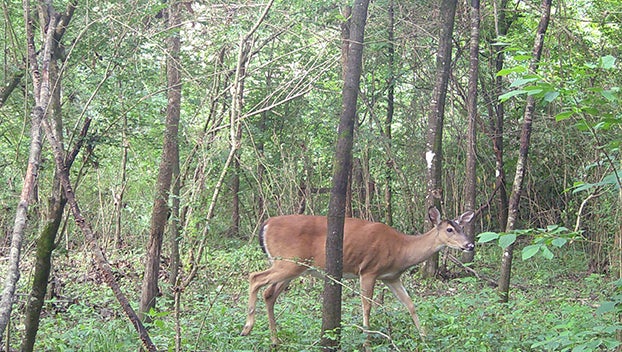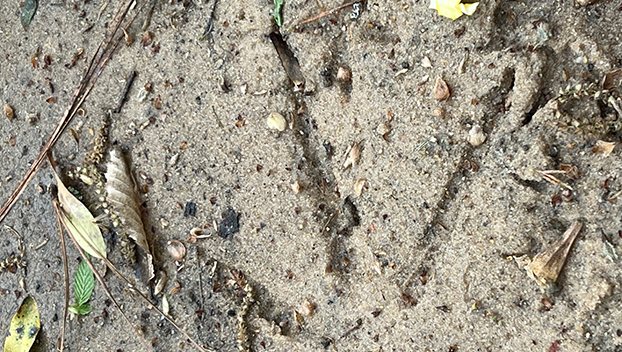Mississippi hunters could help control deer density
Published 3:04 pm Friday, October 6, 2023

- Here a deer walks down a path from a creek to a bedding area. Creek crossings make great trail camera survey spots this time of year. (Hunter Cloud | The Daily Leader)
JACKSON — Mississippi’s deer population is estimated to be over 1.5 million according to the Mississippi Department of Wildlife, Fisheries and Parks deer program. It is great for deer hunting but there are some problems with having too high of a deer population.
It seems counterintuitive for a state, which once had to restock its deer population, pushing the need to harvest deer to bring the population down a little bit. MDWFP is asking hunters to take two deer this season instead of the average 1.6 deer per hunter.
A slight increase in harvest rates would keep the population from growing in a landscape limited by food. Assistant Deer Program Coordinator Kamen Campbell said they are able to reconstruct the deer population with harvest data collected by phone surveys, Game Check and Deer Management Assistance Programs and can safely estimate the population is over 1.5 million deer.
“If you look at our population reconstruction it shows deer and percentage of deer harvested and the resulting change the next year. If you harvest 25 percent our population goes down a little bit. 20 percent or less it increases. It gives us a good indicator,” Campbell. “You can keep it from growing simply by harvesting one more deer than the state average this year. Right now, the percent of deer harvested since 2018 was 13, 14, 15 and 16 percent. We could make a major difference by taking one more deer within the bag limit.”
Decline theory
One thing Campbell has noticed is a drop in doe harvest starting in 2014. MDWFP biologists have a few theories as to why the harvest rates have dropped but do not know the exact limiting factor causing the decline in harvest rates.
Campbell said a popular theory within the department is Mississippi’s deer season is too long. Hunters have the opportunity to hunt deer from October 1 to January 31 in most of the state, bow season opened Sept. 30 this year due to a state statute, they don’t feel the pressure to harvest a deer. Campbell’s home state of Pennsylvania harvested 422,960 deer last year with 255,000 of those killed in Pennsylvania’s two week rifle season. Comparatively, Mississippi harvested an estimated 276,690 deer or 17,000 deer per county last year.
Another theory is the use of local deer processors by hunters instead of processing the meat at home has led to harvest decline. Prices are increasing for the processors to clean, butcher and package deer meat so people may think twice before harvesting their second deer of the season.
MDWFP”s latest survey on rifle season participation showed the average hunter in Mississippi spent 18 days afield. Opportunity to harvest deer is there but there is something keeping hunters from pulling the trigger.
Deer abundance study
Campbell conducted a survey on the Natchez Trace to study deer abundance which helps with deer density estimates. Biologists drove a truck 25 mph down the road with thermal cameras mounted on the hood pointing to the road side.
Claiborne County had the highest deer density. In one night, the agency counted 1,057 deer along the trace. The study covered all 300 miles of the trace from Natchez to the Alabama line.
“Port Gibson had the highest number of observations. One night we counted a deer per 150 yards,” Campbell said. “We were trying to figure out the deer abundance over time. Everything south of I-20 had more deer than north. If we use the same technique from one year to the next it will provide us a measure of relative abundance. Over the next 10 years we know the deer herd is increasing. Southwest Mississippi had the highest abundance by far. There are pockets in Claiborne, Jefferson, Adams and Wilkinson with high deer density. I would say as a person if they wanted to manage and balance the habitat they need one deer per 10 acres.”
Deer density matters
Drought conditions will only exacerbate the need for harvest this season. A stressful summer and likely stressful winter could have negative effects on the deer herd.
He said the drought should get deer to move more for food which in turn could help the agency’s goal in increasing harvest rates this year.
“Our population is as high as it has ever been. When you have too many deer they go from browsing high quality species to sub quality species. They are opportunistic and will take whatever is available,” Campbell said. “In a typical year, you can look at high quality browse to better understand the deer pressure but this year isn’t typical. High quality browse such as ragweed, green briar, dewberries and honeysuckles are preferred. You expect them to be utilized. Once they start using non preferred species such as cedar, sweet gum it indicates you have too many deer. When you walk out this year you will see low quality food being browsed. We are three months into a drought. They have too many deer for the time being.”
To make the nutritional problem worse, Southwest Mississippi’s acorn crop is projected to be scarce. Deer can typically eat acorns into January limiting the nutritional stress they experience before spring green up. However, a late frost killed the white oak blooms and red oaks did not fare well.
Too many deer can alter the landscape causing damage to native plants and habitat for birds. Plant composition can be altered on the property when deer density is high.
Campbell has been with the MDWFP for 11 years in the private lands program and deer program. He said his site visits used to be about managing big deer but now land managers are more concerned with feeding the deer or harvesting.
“They are shooting fewer deer,” Campbell said. “Deer should be easier to harvest this year and people need to take advantage of it.”
Hunters can donate their deer to help feed hungry Mississippians if they don’t feel like cleaning it, paying a processor or don’t have enough room in the freezer. Visit Mississippi Wildlife Federation’s Hunter’s Harvest website to learn more.





